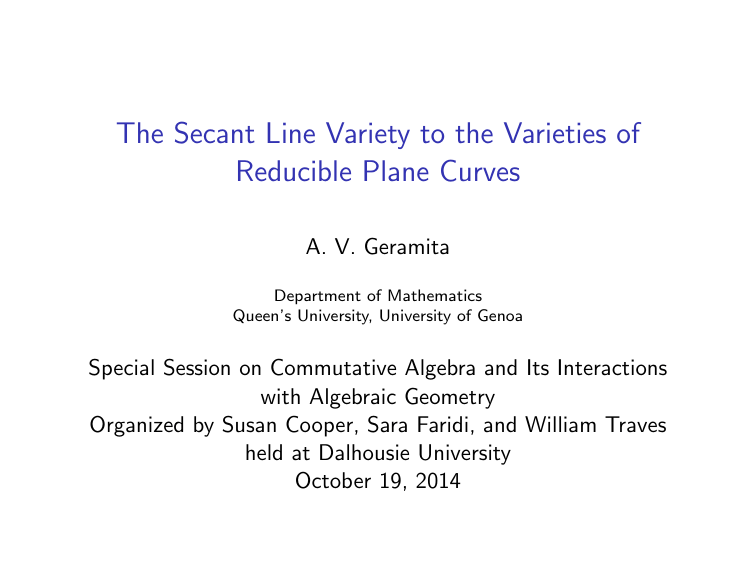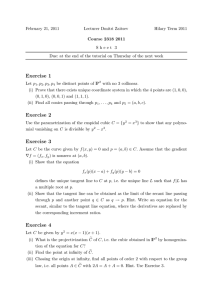The Secant Line Variety to the Varieties of Reducible Plane Curves
advertisement

The Secant Line Variety to the Varieties of
Reducible Plane Curves
A. V. Geramita
Department of Mathematics
Queen’s University, University of Genoa
Special Session on Commutative Algebra and Its Interactions
with Algebraic Geometry
Organized by Susan Cooper, Sara Faridi, and William Traves
held at Dalhousie University
October 19, 2014
Background
(This is joint work with M. Catalisano (Genova), A. Gimigliano
(Bologna) and Y.S. Shin (Seoul), on the ArXiv )
What are the Varieties of Reducible Plane Curves?
Let R = C[x1 , x2 , x3 ] = ⊕i≥0 Ri , let d > 1 be any integer and let
λ
P`r d, be a partition of d into r parts, i.e. λ = [d1 , . . . , dr ] with
i=1 di = d and d1 ≥ d2 ≥ · · · ≥ dr .
Let PN = P(Rd ), i.e. the
projective space based on the vector
space Rd (so N = d+2
− 1) and consider
2
X2,λ = {[F ] ∈ PN | F = F1 · · · Fr , deg Fi = di } .
This is the variety of reducible curves in P2 of type λ.
(There are obvious generalizations to hypersurfaces in Pn with
n > 2.)
More Background
X2,λ is clearly a variety as it is the image of the morphism
P(Rd1 ) × · · · × P(Rdr ) −→ X2,λ ⊂ PN
given by multiplication.
Notice that the general point, P = [F1 · · · Fr ] of X2,λ , has all the
Fi irreducible. Generically, the morphism above is finite to one.
It follows that the dimension of X2,λ is
r r X
X
di + 2
di + 2
− 1 = −r +
.
2
2
i=1
i=1
Secant Line Variety
If X ⊂ PN is any reduced, irreducible variety, we can define the
Secant Line Variety to X as (the Zariski closure of)
{x ∈ PN | x ∈ hP1 , P2 i, Pi ∈ X}.
This variety is denoted by σ2 (X) (we had to choose ”2” points on
X to form the line joining them.)
The question we want to consider in this talk is the following:
What is the dimension of σ2 (X2,λ ) ?
Historical Background
The varieties X2,λ (i.e. the varieties of reducible plane curves) were
first studied in the late nineteenth and early twentieth century:
I C. Segre (1885), plane conics,
I N. Spampianto (1919-22), plane cubics,
I G. Bordiga (1912), plane quartics
All these classical references can be found in the paper by C.
Mammana (Annali della Scuola Normale Superiore di Pisa (1954),
pp 53-75) entitled
Sulla varieta’ delle curve algebriche piane spezzate in un dato modo.
The first paper to consider the dimensions of their secant variety
was by Arrondo and Bernardi (2011, JPAA), followed by Abo
(2014-Jo. of Alg.). They only consider the partitions
λ = [1, · · · , 1]. On the other hand they also consider some higher
secant varieties (i.e. secant plane varieties, etc.), in some cases
also for hypersurfaces in Pn , n > 3.
Our main theorem will give the dimension of σ2 (X2,λ ) for all λ.
Expected Dimension
There is a simple guess for the dimension of σ2 (X2,λ ) based on a
parameter count.
First we have to pick two points on X2,λ , that is a choice in a
2 dim(X2,λ ) space and then we have to add a point on the LINE
joining those two points, i.e. a 1 dimensional choice.
We seem to have 2 dim(X2,λ ) + 1 free parameters.
However, the secant variety lives in PN , where N = d+2
− 1.
2
We say that the expected dimension of σ2 (X2,λ ) is
min{2 dim(X2,λ ) + 1, N} ,
and we define the defect of σ2 (X2,λ ) to be
δ = expected dimension − dim (σ2 (X2,λ )) .
We say σ2 (X2,λ ) is defective if δ > 0.
Terracini’s Lemma
The most important method for finding the dimension of secant
varieties to a reduced and irreducible variety was given by Terracini
(I’ll only state it for the case we are considering in this talk).
(Terracini’s Lemma): Let X be a reduced and irreducible variety
and σ2 (X) its secant line variety. If P1 and P2 are two general
points of X then
dim(σ2 (X)) = dim(TP1 + TP2 )
i.e. the dimension of the linear span of the (projectivized) tangent
spaces at each of the two points.
To effectively use Terracini’s Lemma, we need to figure out a way
to describe the tangent space at a general point of σ2 (X2,λ ).
The Tangent Space
For simplicity I’m going to consider all our varieties as if they were
affine, i.e. cones over the varieties we are discussing.
Thus we are considering the map
A(Rd1 ) × · · · × A(Rdr ) → A(Rd )
given by multiplication.
If p = (F1 , . . . , Fr ), a line through p in the direction (G1 , . . . , Gr ) is
{(F1 + tG1 , . . . , Fr + tGr ) | t ∈ C}.
The image of this line in A(Rd ) is
{(F1 + tG1 )(F2 + tG2 ) · · · (Fr + tGr ) | t ∈ C}.
The Tangent Space
The constant term in this product is P = F1 · · · Fr and the
coefficient of t in this expression is
F1 · · · Fr −1 Gr + · · · + F2 · · · Fr G1 = G1
F
F
+ · · · + Gr
F1
Fr
which gives us a vector in the tangent space to (the cone over)
X2,λ at P.
We conclude:
If P = [F1 · · · Fr ] = [F ] is a general point on X2,λ and IP is the
ideal in R given by
F
F
IP = ( , . . . , ),
F1
Fr
then
TP = P((IP )d ).
Enter Commutative Algebra!
What still remains to do is reinterpret the ideal IP where P is a
general point on X2,λ .
Proposition: Let P be a general point on X2,λ ,
[P] = [F ] = [F1 · · · Fr ] Then
\
F
F
IP =
,··· ,
=
(Fi , Fj ),
F1
Fr
1≤i<j≤r
and so IP describes a finite set of points in P2 which is the union
of an interlocked collection of complete intersections.
We now recall Terracini’s Lemma, which tells us we have to find
the dimension of (IP1 + IP2 )d where P1 and P2 are two general
points on X2,λ , in order to find the dimension of σ2 (X2,λ ).
More Commutative Algebra
But, we have the short exact sequence
0 → IP1 ∩ IP2 → IP1 ⊕ IP2 → IP1 + IP2 → 0 .
It is easy to calculate the Hilbert function of R/IP for P any
general point on X2,λ , so we know the middle dimensions in this
exact sequence. It’s enough then to find the dimension of the ideal
on the left, in degree d.
I.e. to find the dimension of the secant line variety to X2,λ we need
to calculate the Hilbert function, in degree d of the union of two of
these unions of interlocked complete intersections in P2 .
We were able to do that, and we obtain the following complete
classification of the dimensions of the secant line varieties to the
varieties of reducible plane curves.
The Main Theorem
Pr
Notation:
If
λ
=
[d
,
.
.
.
,
d
]
set
s
=
1
r
i=2 di and (when r > 2)
P
p = 2≤i<j≤r di dj (note s and p are independent of d1 ).
Theorem: Let R = C[x1 , x2 , x3 ] = ⊕i≥0 Ri . Let
λ = [d1 , . . . , dr ] ` d and let X = X2,λ . Set N =
d+2
2
− 1. Then:
I
If r ≥ 6 and d1 < s then dim (σ2 (X)) = 2 dim X + 1 ≤ N;
I
If r ≥ 6 and d1 ≥ s, then σ2 (X) is defective and
d1 − s + 2
δ = min
, 2p − 3s
2
I
If r = 2, σ2 (X) is never defective;
I
If r = 3, 4 or 5, and d1 < s, then σ2 (X) is not defective.
(There are times (completely enumerated) when d1 ≥ s and
σ2 (X) is not defective.)
Into the future .....
The four of us with Brian Harbourne, Juan Migliore and Uwe
Nagel have now found the dimensions of σ2 (Xn−1,λ ) for any n.
W’ve also done much more, but that will have to await another
day.
Thank You.


